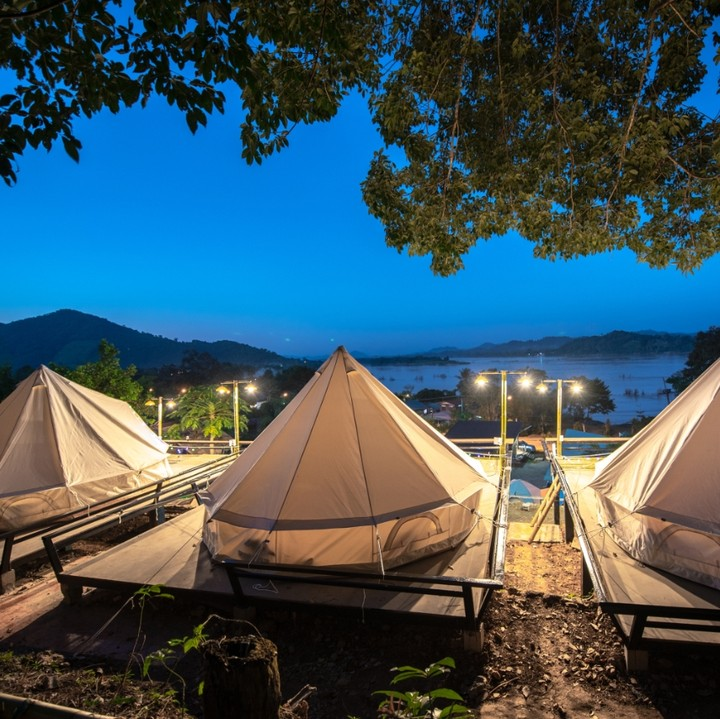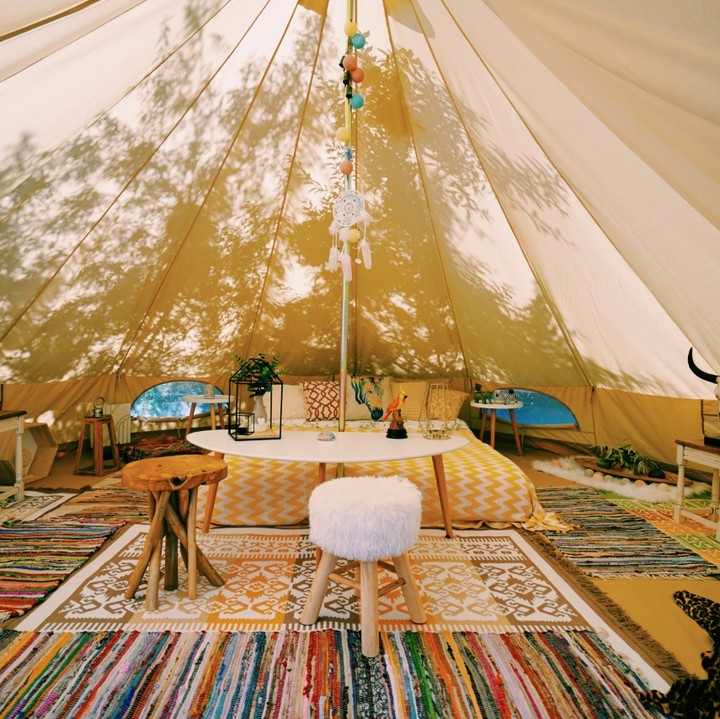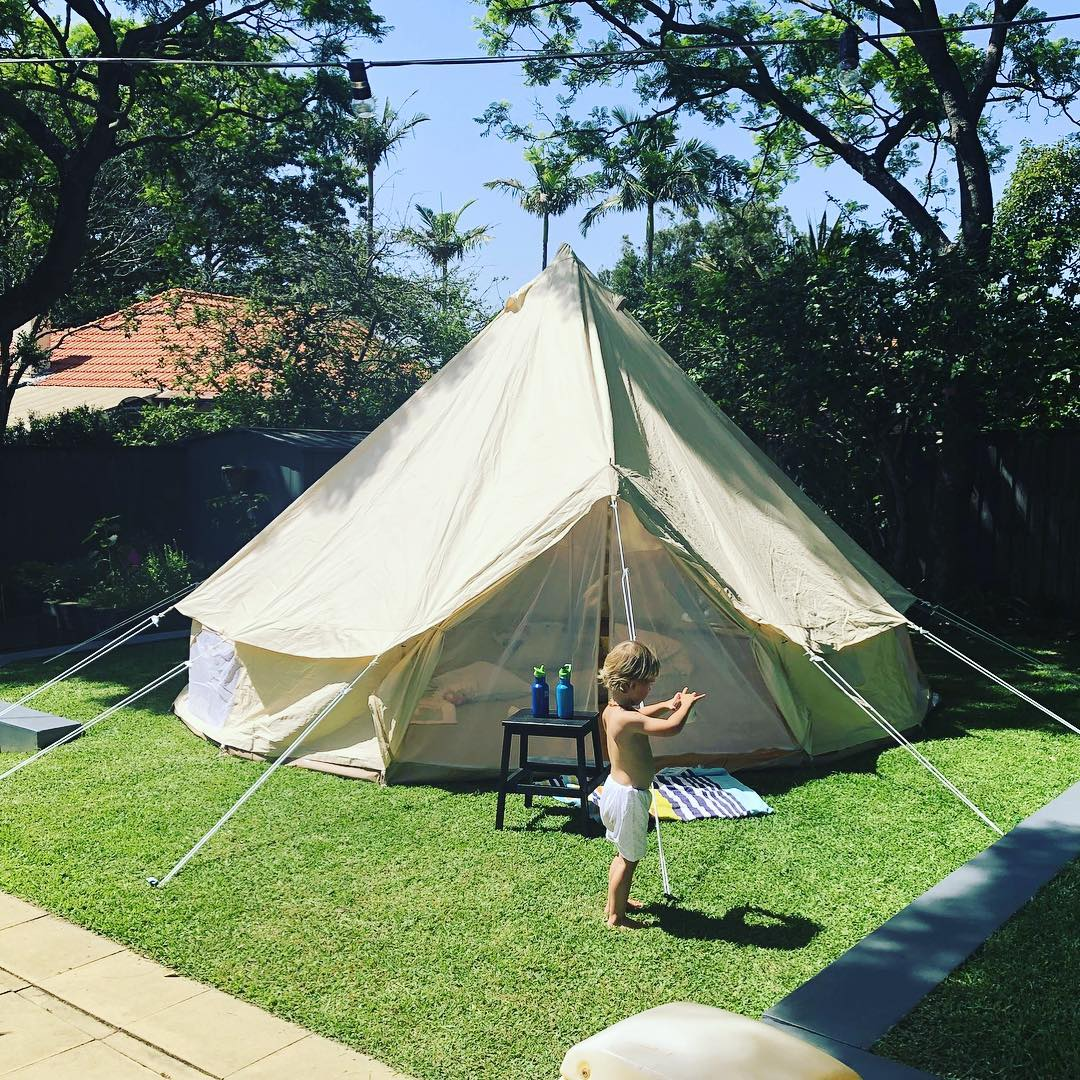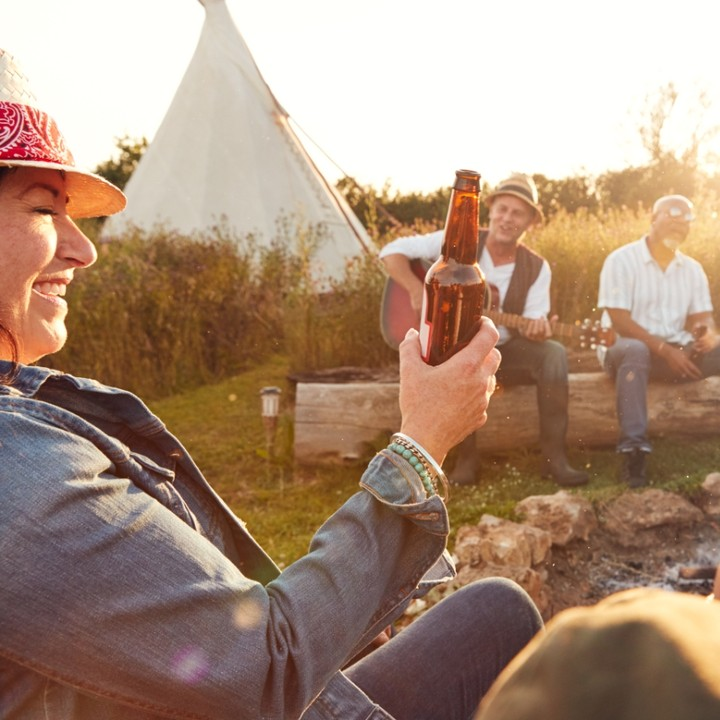What is a Bell Tent?
Jan 08, 2023
Bell tents have soared in popularity recently, used for music festivals, family holidays, weddings, parties, and weekend getaways.
For outdoor enthusiasts looking to indulge comfortably, bell tents are a great option and offer an elevated experience. They offer comfortable, cosy, and flexible living space for camping while giving you a unique experience.
Whether you are just getting started in the glamping world or are a veteran camper looking for the ideal tent, a bell tent could be what you are looking for.
However, with so many tents available, it can take time to understand where to start.
For this reason, this article offers a guide to buying a bell tent, from what size to buy to the required accessories, to ensure you get yourself a perfect bell tent for years of happy glamping. But first, what exactly is a bell tent?
What is a bell tent?

Create yourself a home away from home!
Is it a tent? Is it a yurt? As the name implies, a bell tent is a multipurpose shelter shaped like a bell. It is a tent style that features a single central support pole and a canvass exterior giving it a classic shape.
A bell tent may look like a yurt if you look at it from a distance, with the entrance designed with an A-frame pole providing a super elegant design.
Its style is made with tension from guy ropes that extend the canvas wall outward around its circumference, creating a stable structure with an A-shaped opening, a roomy interior, and windows that give you a comfy and homey space.
Unlike a yurt, however, it doesn't have flooring or walls.
Its solid structure, ability to accommodate many people and ease of assembly make it a superior and popular solution for glamping needs.
Why are they called bell tents?
Circular canvas bell tents with wooden poles have been used by different tribes and cultures worldwide for hundreds of years. The temporary nomadic lifestyle required them to use structures they could quickly erect, dismantle, and carry to the next destination. The most common and well-known of these structures is the native American Tipi which remained unchanged for hundreds of years.
The modern bell tent originated in the 1850s from traditional tents from America. Henry Hopkins Sibley, a US army officer, drew his inspiration from the structures used by the Native American Indians and used their design features to create the modern and first bell tent. His bell tent had many design features similar to the native American Tipi. The only difference was that instead of the 12 poles that formed the Tipi frame, the new design used one central pole to create a structure that could be erected over a stove or fire pit! Using one central pole also meant that the tent offered ease of portability and pitching.
Sibley’s first bell tent stood about 12 feet in height and 12 feet in diameter. It could comfortably accommodate 12 American soldiers with their kits.
Since those early days, bell tents have been extensively used in many military campaigns and have undergone many modifications to get to the modern bell tent used today.
So when you buy a modern canvas bell tent, you purchase a tried and tested tent design that has undergone years of extensive use by soldiers in the harshest conditions.
What Materials are Used For Bell Tents?
Knowing the material used to make a bell tent is incredibly important to help you determine the type of glamping you'll do and how you’ll care for it. Most bell tents are made from heavy-duty canvas for durability. While 100% heavy-duty cotton canvas tents are considered the best option, lighter-weight fabric tents are also available.
The canvas material should be fire retardant, UV, water, and mould resistant.
-
The material used for groundsheet
When you buy a bell tent, you need to keep the base of your tent dry and clean by investing in a high-quality ground sheet. Ideally, a zipped-in groundsheet is preferred as it offers an ultimate comfortable glamping experience.
There are heavy-duty, and light-duty ground sheets, and the one you choose depends on your camping type.
For example, the light-duty groundsheet is easier to rip and more fragile, hence unsuitable for tough terrains and harsh weather conditions such as strong winds.
A zipped-in groundsheet is crucial to ensure safety if you have pets or kids. Also, consider investing in a groundsheet protector to extend the life of your bell tent.
-
The material used for the poles
Most bell tents come with wooden poles or galvanized steel poles.
Canvas Bell Tents Vs. Nylon Bell Tents

Elegance and class, isn't this view magnificent?
Many modern bell tents are made from synthetic fabrics such as polyester or nylon, which offer good choices for camping and hiking due to their lightweight nature. Synthetic fabrics also are easy to manufacture, are waterproof, and require low maintenance.
However, there are several distinct disadvantages to synthetic fabrics. For example, they don't let air pass in and out of the tent, which causes condensation to form inside. This leads to annoying water drops, mould formation, and moisture damage.
Compared to canvas bell tents, they offer little insulation and are noisy in the wind. When exposed to the sun, they fade and deteriorate. They are also manufactured in toxic environments that are dangerous to the workers and the environment.
On the other hand, canvas is a woven fabric made from highly durable cotton, lets air in and out easily and has a natural feel. It protects campers against cold air during winter, stays cooler in summer, and protects from harmful UV rays.
Cotton canvas tents have high tensile strength and can therefore withstand extreme weather conditions.
Sleeping under a canvas bell tent lets you enjoy your sleep as it doesn't make the flipping sound of strong winds. They also refract the morning light, giving your tent space an amazing glamping vibe.
The few drawbacks of canvases include their heavy weight, extra maintenance, and more expensive than nylon bell tents. However, checking Australian conditions, canvas bell tents remain the best choice.
There you have it!
What To Look For In A Canvas Bell Tent
Bell tents may look similar online but have different features and structures. Sadly, there are several low-quality tents all over. It's, therefore, essential to be watchful when buying a canvas bell tent. Here are a few factors to consider:
-
Hardware. Check for the quality of zips, poles, and pegs. Look for bell tents with strong centres, heavy-duty pegs, and entrance poles.
-
Size-4m or 5m? 4-meter tents can accommodate 3-4 people, while 5-meter bell tents can accommodate 5-6 people.
-
Stitching and finishing. Check for double stitching on the critical areas of stress.
-
Zip-off floor. Check for high-quality zips that can roll up the walls to get fresh air moving in.
-
Fire retardant fabric. Ensure your bell tent is made from fire-retardant material before using a wood stove inside it.

Don’t spoil your glamping trip. Use a fire retardant fabric bell tent to avoid fire outbreaks.
-
Fly-screened walls. Another key feature is the fly screen or mesh wall under the roll-up side walls.
-
Other extras such as pockets, extra large bags for easy packing, entry points for electrical plugs
What is the advantage of a bell tent?

Step outside your bell tent and have fun
-
Bell tents are spacious.
One of the reasons why bell tents are preferred is because they are roomy, can comfortably accommodate a large family, and provide the perfect shelter needed. Their enough and more headroom means you can comfortably stand up inside.
-
The bell tent canvas is waterproof.
-
Bell tents offer UV protection
-
Bell tents have a strong and sturdy structure
-
Bell tents are spacious
-
Bell tents are full of fresh air
How To Set Up A Bell Tent

Set up your bell tent, step a few meters away, and see how beautiful it looks.
Bell tents are easy to set up and take down.
First, choose a viable, clean, dry, flat surface and lay out your tent.
Secondly, stake the tent down, and peg the groundsheet
Thirdly, install, set up the centre pole, and raise the roof
Fourthly, set up A frame by installing the door entrance pole
Finally, attach the guy lines, peg out the guy ropes, and adjust them to create the desired tension.
Is a bell tent good for camping?

A beautiful bell tent for glamp-loving kids
Yes, bell tents are good for glamorous camping, commonly known as glamping. While traditional camping involves a sleeping bag and a simple tent, bell tent glamping involves more comfort and luxury while still reconnecting with nature.
How practical are bell tents?
Create your own home away from home
Bell tents are breathable and can withstand strong winds and other harsh Australian conditions. They are durable and can regulate temperature by keeping you warm in winter and cool in summer. A bell tent is basically a blank canvas. If you want your own creation, you can paint it with weatherproof paints. You can throw in pillows, cushions, and cosy throws to create an inviting and relaxing ambience.
Bell tent versus Yurt, is there a difference?
Bell tents are a stable smaller style of tents than yurts, made from cotton canvas or polycotton. On the other hand, Yurts are really old and originated in central Asia thousands of years ago. They have a wooden meshwork structure and are big enough to accommodate a big group and loads of stuff.
How should you style a bell tent?
Now that you know the tent size you need, it's time to start the fun part of choosing the style and theme for your bell tent.
If you prefer an elegant glamping decor, opt for a simple colour scheme and soft shades of pale pink, cream, or coral. Match your throw pillows with the colour scheme, and add fairy lights to light up your tent's interior.
Choose rich, layered rugs with different funky patterns and colours if you are a bohemian glamping camper.
Add coloured glass lanterns, comfy cushions, and incense to create a warm ambience.
Grab fairy lights and enhance the interior of your tent.
Frequently asked questions
Are bell tents waterproof?
Most bell tents are made from cotton, poly-cotton, and polyester materials which are water resistant. Most people prefer cotton canvas tents since they are long-lasting, hard-wearing, and breathable. On the other hand, polycotton and polyester are the cheaper alternatives.
Can bell tents withstand wind?
Bell tents are durably built and aerodynamic. Hence they can withstand strong winds and other extreme weather conditions. As long as they are properly set up and held down with guy ropes, bell tents will make you enjoy your glamping experience throughout your trip.
Most tents are triangular-shaped, perfect for withstanding strong winds in Australia.
The triangle shape ensures airflow continues around the bell tent without facing resistance like in the vertical walls of traditional tents.
Do bell tents last long?
How long your bell tent will last depends on various factors, including the material it's made of, who manufactured it, the conditions it's used in, how often it's used, how it's taken care of, and many more.
A bell tent is one of the most recognizable family tents for luxury camping or glamping. They are super spacious and the most comfortable glamping alternative with lots of creature comforts. A bell tent should be your best option if you are looking for a durable and stylish tent for a perfect glamping experience.

